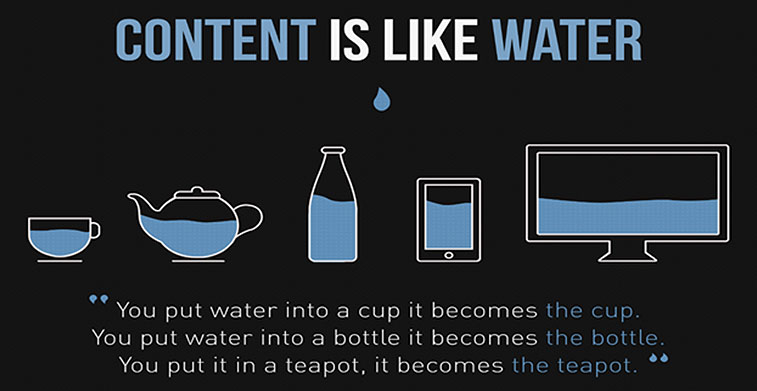Importance of Responsive Web Design

Back in the day, web designers had only one challenge- maintaining the look and feel of a web design in multiple desktop web browsers. However, the increasing popularity of smartphones and tablets have introduced a new challenge for designers to deliver a greater user experience. Websites must now adapt to the advanced browsing capabilities of mobile devices to drive traffic and increase online visibility.
A responsive design must respond to its environment. In this type of layout, designers must ensure that each website element, context, photos, and other UI elements adjust themselves on different devices. Responsive web design allows for an optimal viewing and enhanced user experience between site pages and users. Designed for effortless viewing and minimal navigation- resizing, panning, and scrolling- responsive layouts have become a critical component of company websites’ success. Utilizing a responsive design allows for increased sales and conversion rates, improved audience reach, boost online visibility, and enhanced user experience.
While there are many advantages of a responsive design, your designers must consider many factors when designing this type of layout. Factors such as screen size, resolution, plugins support, and many others must be put into consideration to produce an effective and marketable website.
Because of today’s technology, company websites must adapt to responsive design to be able to keep up with the market trends. If you want to fully maximize your website visibility and increase your conversion rates, here are noteworthy reasons on why responsive design is important for your company websites:
-
Adaptable on multiple devices

In the past 4 years, mobile internet usage was on the rise and has been increasing ever since. Because of technology, advanced technological breakthroughs are skyrocketing. Ancient methodologies and approach on web designs can no longer satisfy market trends and create a great user experience.
In the past, having a company website viewable on the desktop was enough to drive traffic. Today’s technological change has shifted from desktop computers to smartphones and tablets. Because of this change, company websites need to adopt a responsive design to allow for greater user experience and boost online presence. Through a responsive design, your company website can maximize your target market reach. Because most web users rely on smartphones and tablets, your website can easily be viewed by most online visitors.
By adapting to this change, you provide a greater user experience for your target market. In addition, with a responsive website layout, your online visitors can reach you 24/7 on their mobile devices.
-
Greater user experience

User experience refers to the interaction of a user with a certain product. A user’s emotion, attitude, and perception about a product determines whether a great or a poor user experience is achieved. It is important to know what user experience is as this will determine the success of a web design. After all, a company website will only win the market’s heart if it succeeds to deliver the best user experience.
A company website that has a responsive design maximizes website content’s ability to capture the market. One factor to consider with a responsive design is the arrangement of its content. Crowded content arrangement is an eye sore. With a responsive design, your website contents become easy to read and understand without having to zoom in or side scroll on the site.
Remember, providing an excellent user experience is the key to capturing and maintaining your market’s approval. No matter how good your information is and no matter how good your products and services are, if online users are struggling and having difficulty to navigate through your company site, they will immediately move on to the next site and forget about you.
-
Improved SEO rankings

On April 21, 2015, Google announced that a responsive design will favor search engine algorithms and rankings, satisfying responsive websites that are fully optimized for mobile configurations. Major changes like this shouldn’t be taken lightly and business owners with company websites must take advantage of this situation to maximize opportunities for increased online visibility and presence.
Google favors websites that can maximize optimal user experience. Any factor that contributes to usability of a site is rewarded by Google. As mentioned in number 2, responsive designs provide a great user experience. Responsive designs also contain a single URL for separate mobile platforms which Google approved of. In addition, mobile devices have separate search algorithms. Your website ranking on desktop is not going to be the same on mobile platforms. And because of technology, mobile searches will continue to rise over time versus desktop searches. To fully utilize this advantage, company websites must adapt to these changes and start resorting responsive designs.
While there has been many updates on factors that affect a website’s rank from Google Panda to Google Penguin, according to Google, a responsive layout will have a major effect on SEO.
Another factor to consider is that responsive design cut content duplicates. Because of this layout, designers and developers no longer had to create multiple web layouts that are specific to a certain device. With a responsive layout, your company website will automatically adjust its size depending on the device it is viewed. As we all know, Google hates content duplication.
-
Cost Effective

In the past designers have to design and develop multiple website versions that allow for viewing on different platforms from desktop and laptop to mobiles and tablets. Each separate layout adjusts itself depending on the screen size of the device. As such, this method is very costly and time consuming. Because designers have to spend more time on designing on each version according to multiple devices, they must dwell more on developing these pages which are more costly as opposed to developing a stand-alone mobile site.
-
Easier to manage

In the past, before the advent of responsive design, designers develop multiple versions of a single site that will respond to different devices. Because of this, website owners had to spend more time and money in maintaining their websites. Plus, having multiple version of a website would mean that you have to track each site on Google Analytics, which is a tedious task and time consuming. Also, having multiple version of your website would mean that you have to manage each content you have on the site. Content written on your desktop site, ideally would have to match the content on your mobile website. With this, website owners are struggling and a responsive design is the only solution to this.
With the introduction of responsive design, website owners no longer have to worry about maintaining multiple versions of their website. A responsive website means that a company is only managing one website. And because this type of layout is able to adjust on any device, website owners can focus on a single website. With only one website to manage, website maintenance becomes easier to manage.
Additionally, with this layout, company owners easily can pinpoint where their business is weak or strong.
-
Increased traffic and conversion rates

Mobile usage has increasingly becoming popular over the years. Most people heavily rely on their smartphones and tablets for their day to day activities. Because of this mobile searches have dramatically increased over desktop searches. More and more people use their mobile phones to transact businesses online. Furthermore, increasing popularity of online stores and ecommerce applications have been transforming buying habits and behaviors of most people.
Equipping your website with a responsive design will provide online users ease and convenience. They no longer have to go to your office when they want to know more about you or when they want to buy your products especially if you have an ecommerce site. Because responsive layout allows for optimal viewing, you can convert your online visitors into potential buying customers simply because they had a good experience on your site. Simple things really do matter and most importantly with a responsive design, you allow your company website reach its full potential.
Responsive design is just one element of an effective and marketable website. Designers and developers consider many things when it comes to building the ultimate website. Factors such as content, loading time, graphics, design and layout, navigation and functionality, are all taken into consideration in creating an efficient and marketable website.
In this article, importance of responsive design is tackled as one of the factors that contributes to the success of a website. Because of technological advancements, more people are shifting to smartphones and tablets usage. Business owners with company websites have to adapt to these changes to be able to keep up with the market. With its advantages from improved SEO rankings and enhanced user experience to increased conversion rates and traffic, a website equipped with this type of layout can gain true competitive advantage in the market.
Is your company website compatible on multiple devices? Can your target market view your company on their smartphones? Is your website providing an excellent user experience for your potential market? Start utilizing responsive design and enjoy its perks and advantages. Maximize your online visibility through this layout and start converting your online visitors into paying customers.
Do you know any other advantages of having a responsive web design? Comment your thoughts below!